What Causes Storm Surge?
As storm surge, the temporary rise in sea level beneath a storm, becomes dangerous when the storm — typically a hurricane or other tropical storm — reaches land. The water is unable to escape anywhere but onto land as the storm moves toward the shore, which causes flooding along the coast and other types of hurricane damage. For example, the force of waves and currents can cause land to erode and buildings to be destroyed. Saltwater that gets into freshwater lakes, streams, and aquifers is hazardous to aquatic life and contaminates drinking water.
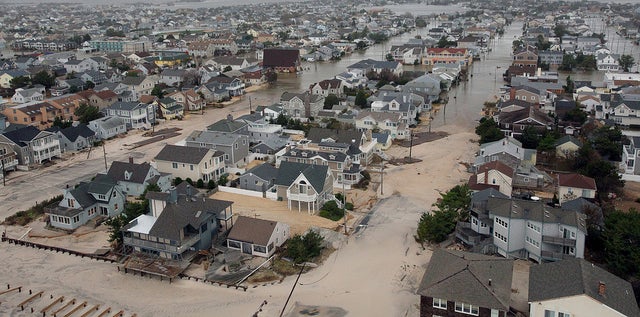
Storm surge flooding in New Jersey by Hurricane Sandy in October 2012
U.S. Air Force photo by Master Sgt. Mark C. Olsen
When high tide occurs at the same time as a storm surge, the combination of the two is called a storm tide. During a storm tide, the water level may be six meters (20 feet) or more above normal. This is especially dangerous for low-lying islands or coastal areas where the land is not much higher than sea level. (Watch a storm surge animation to see what it looks like.)
The amount of storm surge that occurs as a hurricane or tropical storm hits a coast depends on many factors, described below. Computer models, such as the National Weather Service SLOSH model (Sea, Lake, and Overland Surges from Hurricanes) take multiple factors into account, allowing forecasters to customize storm surge predictions for particular storms and coasts.
Wind piles up the water.
As winds swirl around a hurricane or tropical storm, seawater is pushed into a mound at the storm’s center. Faster wind is able to pile up more water. Because wind speed determines a hurricane’s category according to the Saffir-Simpson Scale, Category 4 and 5 storms are able to produce a larger mound of water than Category 1 and 2 storms. The mound of water isn’t noticeable out at sea, but as it approaches a coast, the impact is seen as storm surge flooding.
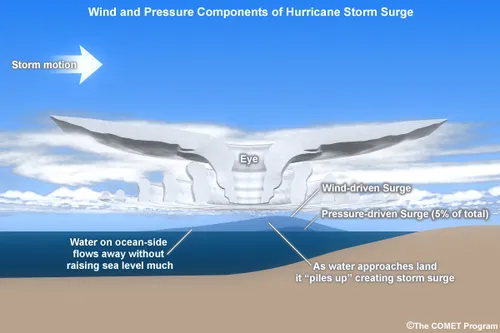
Cross-section of a hurricane moving over the ocean. The storm causes the ocean water to pile up in a mound.
UCAR/COMET
Low air pressure also plays a role.
At the center of a hurricane, air pressure is low. Low air pressure causes a slight bulge in the ocean, which adds to the mound of water that causes storm surge. Most of the water is piled up by wind, but about 5% of the mound is due to low air pressure.
The shape of the coastline makes a difference.
Larger storm surges are more likely along coasts that bow inward than those that bow outward. Places with bays are especially vulnerable because the mound of water can get funneled into a small area.
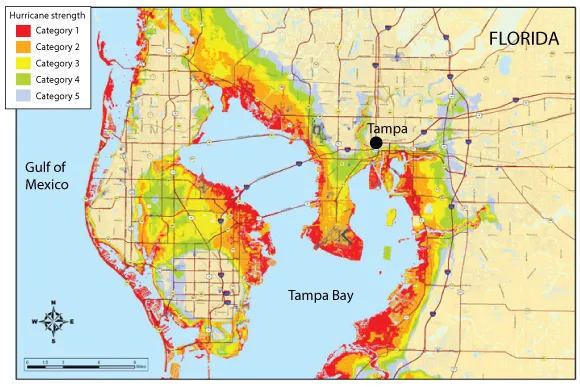
Storm surge risk is higher in Tampa Bay, Florida, than along the coast to the west on the Gulf of Mexico because storm surge water gets funneled into the bay. The map shows maximum storm surge according to the SLOSH model. Because the height of the mound of water is mainly related to wind speed, the colors correlate with hurricane strength (Category), which is determined by hurricane wind speed.
Modified by UCAR from SLOSH/National Weather Service
The shape of the seafloor matters, too.
Coastal areas where the adjacent seafloor is shallow are more likely to be affected by large storm surges than coastal areas where the nearby seafloor is deep.
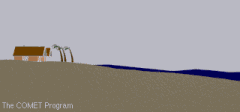
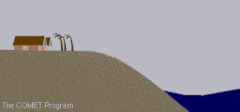
A coastal area next to a shallow sea (left) is more affected by storm surge than a coastal area next to a deep sea (right).
UCAR/COMET
Is the hurricane heading straight for the coast?
The angle of approach makes a difference. A hurricane that heads straight toward a coastline is more likely to cause a large storm surge than a hurricane that hits the coast at an oblique angle or travels parallel to the coast.

When a hurricane approaches the coast directly it is likely to cause a larger storm surge (left) than a hurricane that approaches at an oblique angle (right). For example, Cyclone Yasi made a direct hit on the Queensland, Australia coast in 2011, causing seven meters (23 feet) of storm surge.
UCAR/L.S. Gardiner
The hurricane’s speed matters, but it’s complicated.
Fast-moving storms can cause more storm surge on straight coastlines. Slow moving storms tend to cause more storm surge in coastal areas with bays and estuaries.